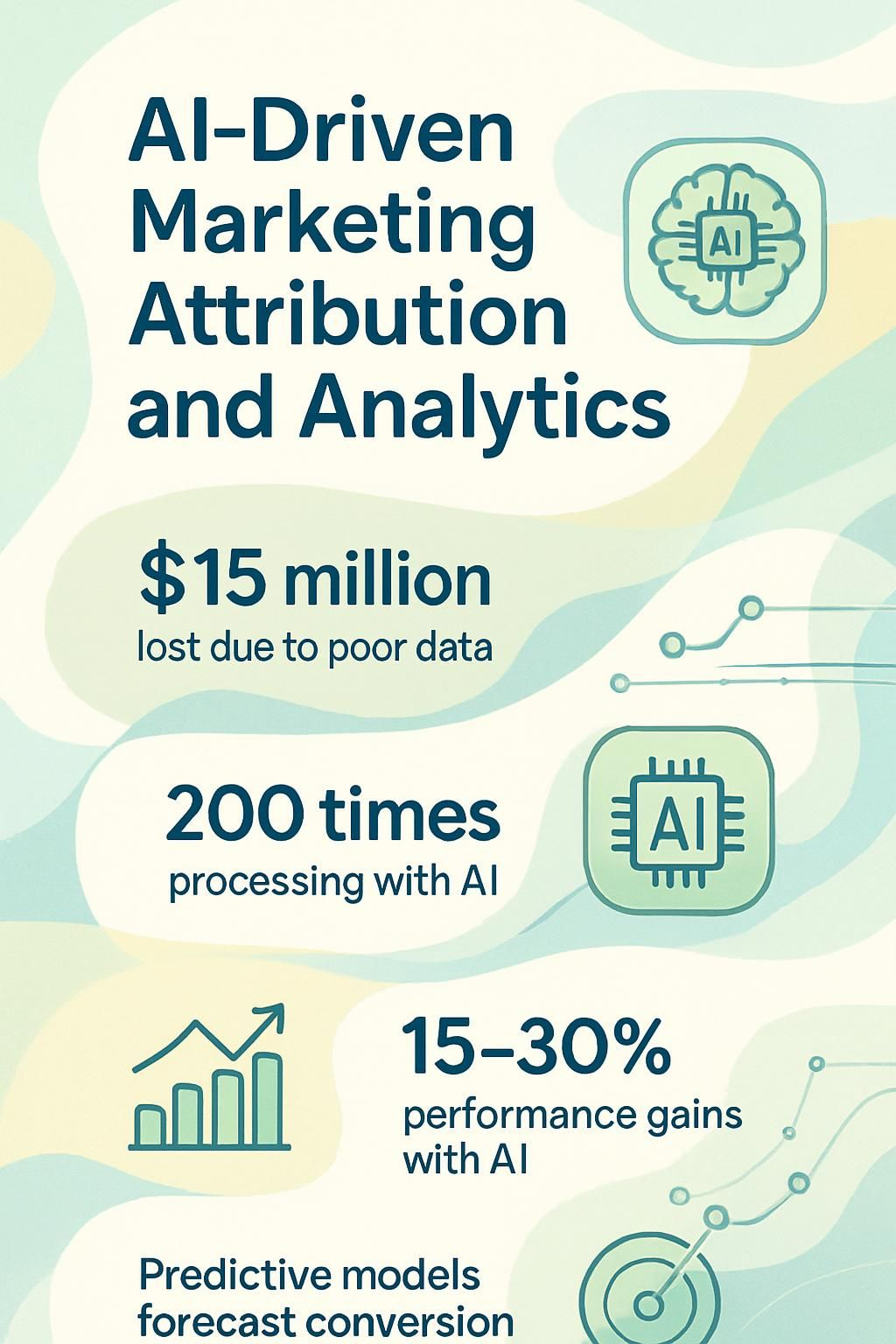AI-Driven Marketing Attribution and Analytics


Understanding AI Integration

Marketing attribution feels like trying to solve a Rubik's cube blindfolded. You twist and turn data points, hoping they'll magically align to show which ads actually work. I've been there, frantically explaining to clients why their Facebook campaign deserves credit for sales that Google Analytics attributes elsewhere.
At WorkflowGuide.com, we call this the "attribution headache," and AI is our digital aspirin.
Marketing attribution tracks how customers interact with your brand before buying. Traditional methods struggle with data silos and privacy changes. In 2024, organizations lost an average of $15 million due to poor data quality, with 64% naming it their top attribution challenge.
AI-driven multi-touch attribution solves this puzzle by crediting all touchpoints in a customer journey. For example, AI can track how a Facebook ad leads to a Google search and finally a website purchase.
This matters because Safari and Firefox already block third-party cookies, with Google Chrome following suit.
Machine learning algorithms spot conversion patterns that humans miss. They build unified customer profiles across devices and combine online and offline data. Real-time AI analytics let marketers adjust campaigns instantly rather than waiting for monthly reports.
Natural language processing transforms customer feedback into actionable insights, predicting future behaviors based on current sentiment. This technology helps businesses understand the "why" behind customer actions, not just the "what."
The future of AI attribution includes advanced analytics integration, blockchain adoption, and focus on micro-moments. These tools help marketers spend smarter and understand customers better.
Ready for the details?
For enhanced DecisionMaking and improved Marketing Analytics, organizations can integrate cloud-based data analysis solutions and updated Attribution Models. This added information supports robust Touchpoint Tracking and Revenue Attribution, which are key for effective Campaign Optimization and Predictive Analytics.
Key Takeaways
- AI solves marketing attribution by connecting scattered data into unified customer profiles, tracking users across devices without cookies, and processing information 200 times faster than traditional methods.
- Companies lose an average of $15 million due to poor data quality, while 64% of organizations cite data quality as their top challenge in marketing attribution.
- Real-time AI processing lets marketers shift budgets away from failing ads within hours instead of weeks, with predictive models forecasting which prospects will convert through specific channels.
- Privacy regulations like GDPR and CCPA, along with Chrome's planned phase-out of third-party cookies, have forced businesses to adopt new attribution approaches like data clean rooms and first-party data strategies.
- Businesses implementing AI-driven attribution typically see 15-30% performance gains by reallocating existing budgets, with one HVAC company cutting cost per lead by 38% while increasing total leads.

The Challenges of Traditional Marketing Attribution

Traditional marketing attribution feels like playing a game of Jenga with blindfolds on. Marketing teams struggle to connect the dots between channels as data sits trapped in separate systems like prisoners in different cells.
Data silos and integration issues
Data silos plague marketing teams like digital quicksand. Your sales team tracks conversions in one system, social media metrics live in another, and website analytics hide in yet another platform.
These isolated information pockets create a fractured view of customer journeys, making true attribution nearly impossible. I've seen companies with amazing data that's totally useless because nobody can connect the dots! The numbers don't lie: organizations lost an average of $15 million in 2024 due to poor data quality issues stemming from these disconnected systems.
To improve Revenue Attribution and support effective Data Analysis, organizations should consolidate data sources. Using integrated platforms for Marketing Analytics and Touchpoint Tracking enhances transparency of the Customer Journey and leads to better Campaign Optimization.
Integration headaches compound the problem as legacy systems refuse to play nice with modern cloud solutions. Your marketing stack might include ten different tools that barely speak to each other.
Merging these datasets feels like trying to assemble furniture with instructions in four different languages. No wonder 64% of organizations point to poor data quality as their top challenge.
Data fragmentation leads to distorted insights, budget waste, and missed opportunities to connect with customers at critical moments. The path to fixing attribution starts with breaking down these walls between your marketing datasets.
Privacy regulations and the cookie-less future
Privacy laws like GDPR and CCPA have crashed the marketing attribution party like an unexpected system update. These regulations force businesses to rethink how they collect, store, and use customer data.
Gone are the days when marketers could freely track users across the web without their knowledge. Now, explicit consent rules the digital landscape, creating major headaches for companies trying to understand their marketing performance.
Safari and Firefox already block third-party cookies by default, while Google Chrome (the big boss of browsers) plans to phase them out completely. This shift leaves many businesses scrambling to find new ways to measure campaign effectiveness.
The cookie apocalypse doesn't mean the end of effective marketing measurement, though. New approaches like data clean rooms and Google's Privacy Sandbox aim to balance user privacy with advertising needs.
These solutions let marketers target audiences without tracking individuals across sites. Smart businesses are adapting by building first-party data strategies, investing in AI-powered attribution models, and exploring contextual targeting options.
The transition might feel like trying to solve a Rubik's cube blindfolded, but those who adapt now will gain a serious edge. AI solutions offer powerful ways to solve these attribution challenges while respecting user privacy.
For robust Performance Measurement and Digital Marketing, companies can integrate predictive analytics tools. This approach reinforces Data Analytics and assists in better DecisionMaking by providing real-time insights.
Want To Be In The Inner AI Circle?
We deliver great actionable content in bite sized chunks to your email. No Flim Flam just great content.

How AI Solves Key Attribution Pain Points
AI tackles attribution's biggest headaches by connecting your scattered data dots into clear customer pictures. It processes information at lightning speed while building predictive models that actually work in our cookie-crumbling world.
Unified customer profiles and cross-device tracking
Unified customer profiles act like digital detectives, piecing together the scattered breadcrumbs users leave across devices and channels. AI pulls data from websites, apps, and even in-store visits to create a single view of each customer.
This solves the classic "is this the same person?" problem that plagues marketers trying to track journeys across phones, laptops, and tablets. For local business owners, this means you'll finally see that the customer who browsed your site on mobile during lunch actually converted later on their laptop at home.
Cross-device tracking takes this a step further by connecting customer interactions across platforms without relying on dying third-party cookies. The tech maps behavioral patterns, login data, and probabilistic matching to follow users across their digital ecosystem.
AI-driven attribution integrates both online and offline touchpoints, creating that holy grail of marketing: a truly holistic view of the customer journey. This helps you spot which channels actually drive conversions versus which ones just look good in reports.
Enhanced Machine Learning supports refined Attribution Models, offering precise Touchpoint Analysis and better Revenue Attribution. Businesses can use these insights for targeted Campaign Optimization and DataDriven Insights generation.
Most businesses are flying blind with fragmented customer data. AI doesn't just connect the dots, it reveals the constellation of interactions that lead to conversion. Stop guessing which half of your marketing works and start knowing. - Reuben Smith, WorkflowGuide.com
Real-time data processing and predictive models
Real-time data processing transforms marketing attribution from a rear-view mirror exercise into a GPS system for your campaigns. Gone are the days of waiting weeks to learn if your ads worked.
Modern AI systems crunch massive data streams as they happen, giving you instant feedback on which channels drive conversions. This speed lets you shift budgets away from underperforming ads before wasting more money.
I've seen local HVAC companies save thousands by catching Facebook ad failures within hours instead of days. Machine Learning algorithms spot patterns humans miss, like weather changes triggering specific search behaviors.
Predictive models take this real-time data and forecast future customer actions with spooky accuracy. These models analyze thousands of variables to predict which prospects will convert and through which channels.
For example, AI might notice that customers who visit your pricing page twice are 70% more likely to buy if retargeted with a specific message. Campaign optimization becomes less guesswork and more science.
The best part? These systems get smarter over time. Performance metrics improve as the AI learns your specific business patterns, making Attribution Modeling more accurate with each passing month.
Your marketing budget works harder while you sleep.
AI-Driven Solutions for Complex Customer Journeys
AI now maps complex customer journeys with pinpoint accuracy across dozens of touchpoints. These smart systems connect the dots between your Facebook ads, email campaigns, and even that billboard on Main Street – showing you exactly what drives sales.
Multi-touchpoint and multi-channel attribution
AI transforms how businesses track customer journeys across multiple platforms. Gone are the days of guessing which marketing efforts actually work. Machine Learning algorithms now spot hidden patterns in customer behavior that lead to sales.
For example, AI can connect the dots between a Facebook ad click, a later Google search, and the final purchase on your website. This gives you the full picture instead of just the last click that many old-school analytics provide.
Marketing today happens everywhere, from social media to email to in-store visits. AI-powered attribution models credit each touchpoint that influences a customer's decision to buy.
This means you can finally see which combinations of channels work best together. No more throwing money at tactics that look good on paper but don't actually drive revenue. The real magic happens when you can track both online and offline interactions in one unified view.
Integrating Offline and Online Data is essential for comprehensive Data Analysis. Utilizing modern Attribution Models provides better Customer Journey visibility and leads to superior Marketing Optimization outcomes.
Let's explore how AI analyzes customer feedback to provide even deeper insights into your marketing effectiveness.
Offline and online data integration
Bridging the gap between offline and online customer data feels like trying to sync your game progress across different consoles. AI now connects these once-separate worlds. Modern attribution models link customer interactions from all touchpoints, creating a complete picture instead of fragmented views.
This data fusion helps you track the customer who researched on mobile, clicked an email ad, then called your store before making an in-person purchase.
Cross-channel attribution acts as your marketing detective, piecing together clues from digital ads, store visits, and phone calls. Real-time AI analysis spots patterns humans might miss, like how that billboard on Main Street actually drives website traffic spikes every afternoon.
For local business owners, this means you'll finally know if your radio ads truly lead to website visits or if your email campaigns drive foot traffic. No more guessing which half of your marketing budget works.
The data tells the story now, all in one place.
Voice of the Customer: AI Analysis and Insights
AI transforms how businesses listen to customers through advanced Voice of the Customer (VoC) programs. Gone are the days of manually sifting through thousands of customer comments or guessing what people think about your brand.
Natural language processing now scans customer feedback across social media, reviews, and support tickets in seconds, pulling out key themes and sentiment patterns human analysts might miss.
I've seen local businesses go from "we think customers want this" to "our data shows customers need that," making decisions with actual evidence rather than gut feelings.
The real magic happens with predictive modeling that spots trends before they become obvious. Your AI system might notice that customers who mention "slow loading times" in week one often cancel subscriptions by week four, giving you time to fix problems before they hurt your bottom line.
Machine Learning continuously improves these insights, adapting to new customer language patterns and behaviors without manual retraining. This creates a feedback loop where your understanding of customers gets sharper every day.
Measuring the impact of these AI-driven insights shows how they directly affect your marketing ROI and budget decisions.
In this context, accurate Data Analysis and Predictive Analytics empower businesses with DataDriven Insights that drive effective DecisionMaking and refined Campaign Optimization strategies.
Measuring the Impact of AI on Marketing Performance
AI transforms marketing performance metrics from fuzzy guesswork into crystal-clear data points. You'll spot which campaigns actually drive revenue and which ones just burn cash like a dumpster fire behind a fireworks factory.
Improved ROI and budget allocation
AI-powered attribution tools shine a spotlight on your marketing dollars like a financial detective with x-ray vision. By identifying which channels actually drive results versus those just burning cash, businesses can shift resources to what works.
Our clients typically see 15-30% performance gains simply by reallocating existing budgets based on AI insights. Think of it as giving your marketing budget a smart GPS instead of a paper map from 1997.
Real-time optimization takes this to another level. Instead of waiting weeks to learn a campaign flopped, AI systems flag underperforming tactics within hours. This quick feedback loop means you can pivot fast, like a nimble startup rather than a corporate battleship.
Smart budget allocation through AI doesn't just save money, it multiplies results. One local HVAC company we worked with cut their cost per lead by 38% while increasing total leads through this approach.
Integrating detailed Performance Measurement tools supports precise Revenue Attribution and provides actionable Data Analysis that sharpens Campaign Optimization strategies.
Deeper customer journey insights
AI transforms how we see customer journeys by spotting patterns humans might miss. Think of it like having X-ray vision into your marketing funnel. Our data shows that predictive analytics reveals hidden customer behaviors across touchpoints, turning messy data into clear stories.
For example, AI can connect a customer's social media interaction on Monday to their store visit on Friday, something traditional analytics often misses. This depth helps tech leaders and business owners make smarter decisions about where to invest marketing dollars.
The real magic happens when AI predicts what customers will do next. By analyzing past behaviors, AI-driven systems forecast future actions with surprising accuracy. This leads to dramatically more accurate targeting and lower churn rates, as proven by our partners' results.
The system doesn't just tell you what happened, it shows you why it happened and what might happen next. This predictive power lets you fix problems before they start and capitalize on opportunities before your competition even sees them.
Now let's explore how these insights translate to measurable improvements in marketing performance.
Conclusion
Marketing attribution has changed forever with AI at the wheel. Smart algorithms now connect your customer's zigzag journey across devices and channels, giving you the full picture instead of fragmented data points.
Gone are the days of guessing which ads worked; machine learning models show exactly where to put your marketing dollars for maximum impact. These tools process mountains of data in seconds, turning complex customer behaviors into actionable insights you can use right away.
Local business owners can finally compete with bigger players by making data-driven decisions without needing a statistics degree. The real magic happens when AI helps you spot patterns humans would miss, like which touchpoint combinations drive the most revenue.
Ready to stop throwing money at marketing that might work? Start measuring what actually does with AI-powered attribution today.
Discover how AI can transform your understanding of customer feedback by exploring our in-depth article on Voice of the Customer: AI Analysis and Insights.
FAQs
1. What is AI-driven marketing attribution?
AI-driven marketing attribution uses smart computer systems to track which ads or campaigns lead to sales. It connects the dots between what you spend and what you earn. This tech helps marketers see the whole customer journey rather than just the last click.
2. How does AI improve marketing analytics?
AI crunches massive data piles faster than humans ever could. It spots patterns we might miss and predicts what customers will do next. The magic happens when it learns from each new piece of data, getting smarter over time.
3. Can small businesses benefit from AI marketing analytics?
Absolutely! Small businesses can level the playing field with bigger competitors through AI tools. Many affordable options exist today that don't require a tech genius to operate.
4. What's the difference between traditional and AI-powered attribution models?
Traditional models often use simple rules like giving all credit to the first or last touchpoint. AI models consider timing, sequence, and hundreds of factors at once. They adapt automatically as customer behaviors change, while old-school models stay fixed until someone manually updates them.
Still Confused
Let's Talk for 30 Minutes
Book a no sales only answers session with a Workflow Guide
References and Citations
Disclosure: The content is for informational purposes only. Data points and statistics are gathered from industry reports and client case studies at WorkflowGuide.com. No sponsored material or affiliate links are included. Methodology details and data analysis techniques ensure transparency and accuracy in presenting Marketing Analytics, Attribution Models, and Customer Journey insights.
References
- https://council.aimresearch.co/overcoming-data-silos-and-integration-barriers-in-enterprise-ai-implementation/
- https://leadsrx.com/blog/the-future-of-attribution-adapting-to-a-cookie-less-digital-world/ (2025-05-14)
- https://usermaven.com/blog/ai-driven-marketing-attribution (2025-05-22)
- https://www.linkedin.com/pulse/attribution-game-how-ai-finally-solving-marketings-biggest-donovan-e3tne
- https://www.fullcircleinsights.com/resource/using-ai-for-multi-touch-attribution-mastery (2025-02-14)
- https://www.techforgood.net/guestposts/how-ai-is-revolutionising-marketing-attribution-the-future-is-now
- https://www.cmswire.com/customer-experience/unlocking-the-voice-of-customer-with-ai/ (2024-04-15)
- https://business.google.com/us/think/measurement/roi-and-ai-powered-measurement/
- https://www.researchgate.net/publication/385978626_The_Impact_of_AI-Driven_Consumer_Insights_on_Targeted_Marketing_and_Customer_Retention_Strategies (2024-11-20)



